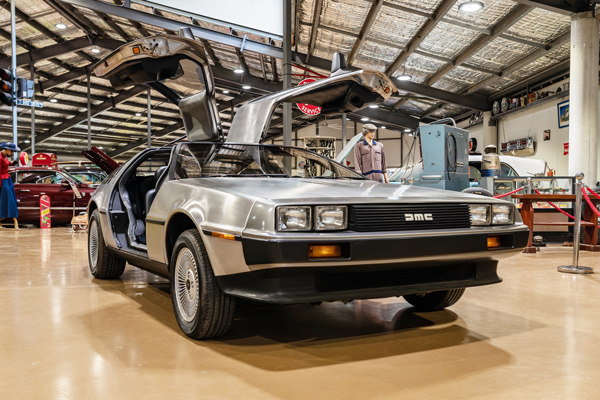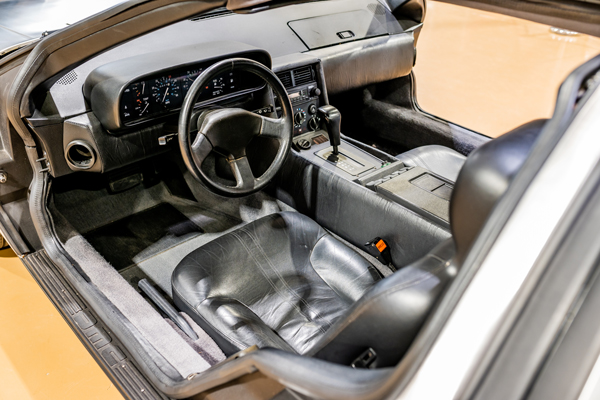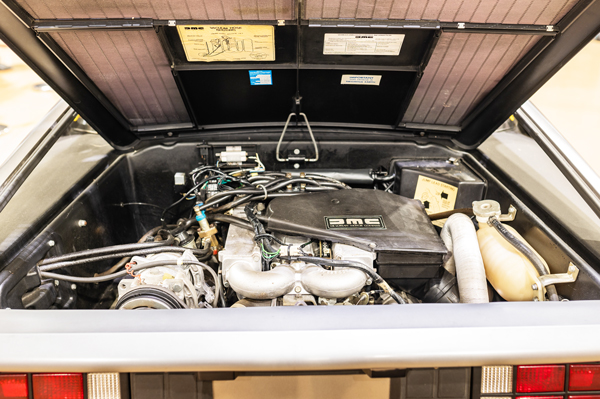Classic Car | 40 Years of the Delorean DMC-12
If you are asked to name an iconic motor car, it’s entirely possible the first model you’ll think of is something like the VW Beetle, Mark I Mini, Porsche 911, the Ford Mustang or some other big-selling classic that had a major impact on the automotive industry.
And that’s fair enough – they are all influential and special in their own way, have immense longevity and sold by the bucketload.
And yet it is also possible that the name you come up with is that of a car that had a production life of just two years, of which just 9000 units were made, which was reportedly hamstrung by build-quality issues, which was not as quick or as slick as its competitors, which was at the centre of one of the most bizarre and scandalous corporate business stories ever, and which found fame as the centrepiece of a series of blockbuster Hollywood movies.
That car is, of course, the DeLorean DMC-12, and its story is a ripper of a tale.
The car was the dream project of former GM executive John DeLorean, who had been an engineer with Pontiac and had made a name for himself as the man who, in 1964, kicked off the muscle car craze by stuffing a massive V8 into the midsize Pontiac Tempest, creating the performance-focused Pontiac GTO.
Branded as an automotive wunderkind, DeLorean would go on to become the head of Pontiac (at age 40, he was the youngest ever boss of a GM division), and then Chevrolet – turning both into sales monsters – before finding himself elevated to vice-president at GM and apparently destined for the top job at the world’s biggest carmaker.
That was not to be. Considered something of a maverick in the staid and serious-minded world that was corporate America of the time, DeLorean left GM in 1973, determined to make his mark producing his own cars under the banner of DMC – the DeLorean Motor Company.
By 1976, the prototype of the first DMC model made its debut. Known as the DSV-1 (DeLorean Safety Vehicle), it was to be a car that was safe, economical and rustproof, and was designed by legendary Italian car designer Giorgetto Giugiaro of ItalDesign.
Giugiaro followed DeLorean’s requests for a car that had gullwing doors, a mid-engine layout that utilised a Wankel rotary engine, and a stainless-steel body. Specs also included using a radical construction method involving Elastic Reservoir Moulding (ERM) – in which 2cm-thick sheets of urethane foam were sandwiched between sheets of fibreglass – a material that was touted as being very light, strong, and stiff enough for the job.
As it turned out, meeting these specifications proved a little tough and the rotary engine idea was abandoned in favour of a piston-driven motor. This change necessitated an alteration in engine placement with the fuel-injected, 2.85-litre PRV V6 (jointly developed by Peugeot, Renault, and Volvo) that was ultimately chosen, sitting further back giving the car a rear-engine layout.
The ERM material was also problematic and subsequently abandoned in favour of a fibreglass body upon which would be attached the stainless-steel panels.
DeLorean contacted Colin Chapman, founder and boss at Lotus, to help get the car ready for production and the British firm worked furiously to meet a tight deadline to get the car done, giving it a backbone frame, independent suspension, and new steering system – a set-up that could be found under the skin of the Lotus Esprit model of the time.
These changes to the DeLorean’s original design became a contentious issue, ultimately leading to the departure from DMC of Bill Collins, the company’s chief engineer and the man behind the prototype.
It would not be last issue DeLorean would face.
Raising the money for his pet project and finding somewhere to build a factory and put the car into production was, of course, a major problem. DeLorean could rely on his up-to-then seemingly spotless record of success in the industry, and the charismatic executive – who was something of a celebrity and had even chosen to have plastic surgery to give himself a more chiselled, movie-star look – approached his Hollywood pals for investment while also raising money from dealerships across the US who were eager to add the stunning-looking car to their inventory in exchange for a share in the company.
This was not enough to raise the cash needed, however, and DeLorean began approaching governments around the world for the funds and a place to build his car, now known as the DMC-12 (with the 12 representing the proposed asking price of $US12,000).
And this is where things get spicy as DeLorean found himself moving from the world of business and celebrity and into a world of business and politics.
He managed to get the government of the Republic of Ireland interested in the project, although they ultimately didn’t buy in. However, across the border in Northern Ireland – a province wracked by the sectarian violence of the Troubles, and in dire economic strife and suffering from high unemployment – DeLorean found a willing partner in Britain’s Labour government, which stumped up more than $100 million for DMC to build a factory near Belfast and employ thousands of locals desperately keen to work.
Construction of the factory began in 1978 and production of the car finally started in 1980 with the first unit rolling off the production line at the beginning of 1981.
30,000 units were targeted for that first year with all cars destined for the North American market.
Quality issues were evident from the start. According to the terrific documentary series Myth & Mogul: John DeLorean (currently available on Netflix) a reporter who was given a pre-production DMC-12 to test, drove the car up to his camera crew who were waiting for him to open the gullwing door with a flourish and announce that ‘This is the DeLorean Dream’. Unfortunately, the door wouldn’t open. Not only that, but the window wouldn’t either, trapping the reporter inside. It was, apparently, an issue that plagued some of the first display models that eager dealers placed in their showrooms. It was not a good look.
These problems would be ironed out over time and DeLorean was confident enough that he was making plans for both a turbocharged version of the car, as well as a four-door version to be called the DMC-24. He also had time to promote a 24k gold-plated version of the DMC-12, of which three were made and were available for a wallet-busting $85,000 each!
However, within a few months, the dream would turn into a nightmare.
By the end of 1981, sales were not powering ahead as hoped, there were accusations of some financial shenanigans, the sale price of $US25,000 was considerably more than the $US12,000 that had been mooted, and reviews by the motoring press were not all that stellar, with the car’s performance not matching up well against its contemporaries.
For example, the 1981 Lotus Esprit Turbo had a 2.2 litre, four-cylinder turbo engine that produced 156kW and 270Nm – good enough to push that sleek car to a top speed of 250km/h and a 0-100km/h time of around 5.7 seconds. The 2.85-litre PRV V6 engine of the DMC-12 produced 97kW and 207Nm that enabled the DeLorean to reach a top speed of 209km/h and a 0-100km/h time of about 9 seconds.
As things took a downturn, DeLorean found Britain’s new Conservative government – under the leadership of Margaret Thatcher – loathe to pump more money into the company without private investment also being injected.
In February 1982, with its finances on the ropes, DMC was put into receivership, allowing a slimmed-down version of the company to keep producing cars. DeLorean went on a mission to drum-up support and raise more money.
And then everything came crashing down.
In October 1982, DeLorean was caught in an FBI sting operation, videotaped at a Los Angeles hotel allegedly agreeing to a drug trafficking deal. While he would be ultimately acquitted of all charges, the damage was done – his reputation was in tatters and his car company beyond saving.
It was all over. Well, not quite.
In 1985, the DMC-12 found a new level of fame and popularity as an integral part of the story of the blockbuster movie Back to the Future and its sequels.
The interest in the car was still there and, as it happened, there were plenty of parts, panels and components left over from the demise of the original DMC company. What was left was purchased by British-born mechanic Steve Wynne, who founded a new DMC company in 1995 and has been threatening in recent years to relaunch the car.
Earlier this year, in fact, the word was the DeLorean could reappear as an EV.
Whatever happens in the future, the DMC-12 – even with all the mighty baggage of scandal and mischief that surrounds its creation and production – is an iconic piece of motoring history.
It may not be the quickest, the most comfortable, the best driving, or indeed meet any of the high benchmarks by which a sports car of the time might be measured.
However, it is, one could argue strongly, amongst the best-looking cars of all time.
If it were to be unveiled as a brand-new model today, it would still draw the eye – and that glorious stainless-steel body, those gullwing doors, and that very cool, wide and low stance are not to be dismissed.
Be honest, you’d have one, wouldn’t you?
VIDEO: ORIGINAL 1981 DELOREAN TV COMMERCIAL
The Delorean MDC-12 at the Gold Coast Motor Museum
The glorious DeLorean DMC-12 you see on these pages can be found, along with dozens of other beautiful classic vehicles, at the Gold Coast Motor Museum in south-east Queensland.
Owned by the museum’s founders, brothers Carl and Grant Amor, who generously allowed Motor Trader onto the premises to take these images, the DMC-12 is in top-top shape and a terrific example of the iconic machine.
“We bought it about five years ago in the US,” said Grant. “It had been owned by a lady in California, then it went to a private museum and then we bought it, so we are the third owners.
“And it is in the condition that we bought it – it has done 8600 miles (13,840km) and we even have the original tyres. They were hard, and probably unsafe, but we do still have them, and they are barely worn. We took them off just for safety reasons as we have driven it a bit.
“We know that it is an early model because the early ones had the petrol flap cut into the bonnet. They made a lot of changes to the car during its production, so they changed that later, but one of the identifiers of the age of the car is that flap.”
For most people who have never been inside a DeLorean, let alone driven one, and who may have the idea that it is a fire-breathing performance monster based on those tyre-scorching scenes from Back to the Future, the truth, it seems, is rather more down to earth.
“It’s not the best to drive,” said Carl with a smile. “I have people asking me that all the time and, while it is OK, it is not anywhere near as stunning to drive as it looks.
“I say to people that the best thing about driving a DeLorean is that you are driving a DeLorean! After that, it is just a pretty ordinary car. However, it is a massive piece of automotive history.”
Source: Motor Trader e-Magazine (October 2021)
22 October 2021












